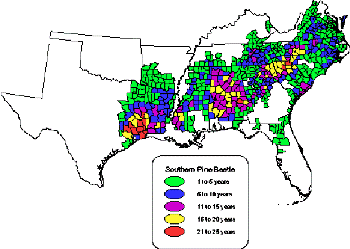Written by J.D. Ward and P. Mistretta for Forest Encyclopedia Network
The southern pine beetle (Dendroctonus frontalis Zimmermann) is a serious pest of pines in the southern United States, Mexico, and Central America. The southern pine beetle (SPB) kills pines by boring under the bark and destroying the cambium layer of the tree. Trees are often mass attacked by thousands of individual southern pine beetles. Because populations can build rapidly to outbreak levels, large numbers of trees can be killed and forested ecosystems seriously affected. Infested areas may range from 10 trees to several thousand acres. Large areas are often killed before land managers are aware of the beetles’ presence. SPB populations vary widely between years and are cyclic in nature, normally peaking in magnitude on roughly an 11- to 15-year cycle. The SPB can be found from northern Nicaragua to the United States, Maryland to Arizona. The most contiguous populations occur in the southern states, especially in the range of shortleaf pine. Most species of pine are susceptible to attack during intense outbreaks (Figure 1). In the southern Appalachians, shortleaf, Virginia, pitch, table mountain, and eastern white pine are attacked (Price 1994). Homogeneous pine stands are more susceptible than those mixed with hardwoods. Outbreaks in Tennessee, North Carolina, South Carolina, Virginia, and Georgia were recorded as early as the late 1700s and early 1800s.

Until the late 1940s, little was done in the South to control forest pests. After World War II, state and federal agencies in the South began to recognize forest protection as a necessary part of forest management. Maximizing the production of wood and wood fiber in the South became desirable because of a national wood shortage associated with the housing boom following World War II. Through the 1950s, ’60s, and ’70s, forest management was commodity or wood product driven and damage control of forest pests was highly desired. Congress authorized funds to build the capacity to protect forests at the state and federal levels. State forestry organizations hired forest protection specialists, and universities and colleges began to teach courses about protection of forests from fire, insects, and disease. State and federal agencies, as well as universities, conducted research on forest pests. The worst southern pine beetle outbreak in the southern Appalachians since the 1960s occurred between 1973 and 1976 (SAMAB 1996). Based on the data collected since 1960, over 36.6 million cords of pine pulp and saw timber, worth more than $901 million was destroyed. To combat such losses, pest control methods were developed that were highly effective in protecting trees but not always beneficial to other forest values.
Emphasis was placed on chemical control, especially after the development of chlorinated hydrocarbon pesticides such as DDT, BHC, and lindane. During this era, control of forest pests required intensive labor and, in many cases, was perceived by many people as being damaging to the environment as well as injurious to the people who applied the treatments. Rachel Carson’s book, “Silent Spring,” decried the existing pattern of pesticide use, calling instead for a more careful use of these chemicals. The book catalyzed the environmental movement in the United States during the 1960s and ’70s. Public outcries against the use of toxic chemicals in the forest resulted in the banning of several pesticides and challenged researchers and managers to develop and use more environmentally friendly methods for controlling forest pests.
Adapted for eXtension.org by Thomas DeGomez, University of Arizona
References cited:
Price, T. 1994. Southern Pine Beetle in the Southern Appalachians. In: C. Ferguson and P. Bowman. Threats to Forest Health in the Southern Appalachians. Gatlinburg, TN.: Southern Man and the Biospehre Cooperative: 21-26.
SAMAB (Southern Appalachian Man and the Biosphere). 1996. The southern Appalachian assessment terrestrial technical report. Atlanta: U.S. Department of Agriculture, Forest Service, Southern Region.
For more on History of Southern Pine Beetle:
- Southern Pine Beetle
- Epidemiology and Infestation of Southern Pine Beetle
- Characteristics of Pine Stands Susceptible to Southern Pine Beetle
- Aerial Survey and Detection of Southern Pine Beetle
- Using Verbenone to Control Southern Pine Beetle
- Biological Controls of Southern Pine Beetle
More Insects in Forests:
- Southern Pine Beetle
- Balsam Woolly Adelgid in Fraser Fir
- Hemlock Woolly Adelgid
- Emerald Ash Borer
- Asian Longhorned Beetle
- Red Oak Borer
- Gypsy Moth
